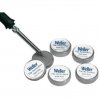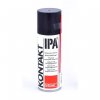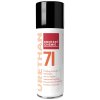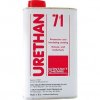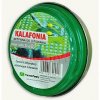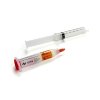Everyone, who´ve ever tried to solder without a flux and then with a flux, probably has seen a big difference in solder spreading and in a resulting joint quality.
This effect is very visible on a PCB with bare copper tracks without any surface treatment (for example at DIY production of prototypes) but there´s also a significant difference at boards with a surface treated by tin (HAL) or by gold (Flash, chemical gold,..).
Maybe you have a question, whether it makes sense to add a flux when it already is in a solder wire? Naturally, fluxes in soldering wires are of a high quality and producers of solders (Stannol, Koki, Multicore,...) try hard to reach uniform releasing at soldering and to show a minimum spatter. Mainly at soldering of small joints this spatter often causes, that a flux won´t get to a solder pad, what significantly embarrasses solderability. The charm of a flux is based on the fact, that it is directly on a solder pad and in the desired thickness, which can be influenced by application.
Especially at soldering of SMT components it´s often even impossible to solder by a method “solder wire in one hand, soldering tool in another”, because we usually need one hand to hold a component in tweezers and moreover - often even a 0.5mm solder wire is too thick to precisely dose a solder directly to a small component in for example an 0402 package. That´s why we usually solder SMT components by a method of taking a little bit of solder on a soldering tip and then applying to a component. But here´s a problem, that a flux won´t survive this a few seconds long “journey” but it will degrade by evaporation, oxidation,… In contrast a flux applied directly to a PCB will replace a missing flux from a solder wire and the difference in spreading of a solder is really huge.
A big advantage is, that in a dry environment the FLUX SK 10 can be left on a PCB as a final protective layer. However in a humid environment it undergoes hydrolysis and degrades. In such environment, it´s better to use Plastik 70, Urethan 71 or Silisol 73.
Detailed information will provide you the FLUX SK10 datasheet. In case of interest, please contact us at sales@soselectronic.com.
- flux - an efficient agent to improve solderability
- wide possibilities of usage on a PCB and any other joints
- also protects from corrosion
- in a dry environment can be left on a PCB as a protective layer
- filled by an environmentally friendly gas (CO2)
- after usage it´s not necessary to clean a nozzle by spraying “upside down”
- available in spray or in 1l/ 5l bulk
Do you like our articles? Do not miss any of them! You do not have to worry about anything, we will arrange delivery to you.
Competition with the following question has been published here:
What´s the recommended drying time after application of FLUX SK 10?



